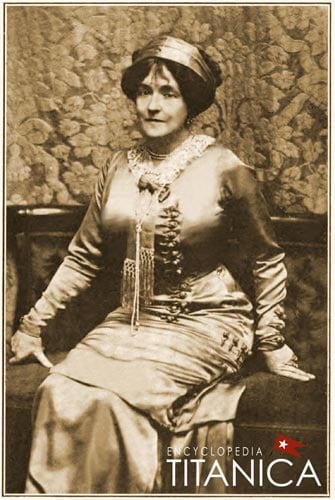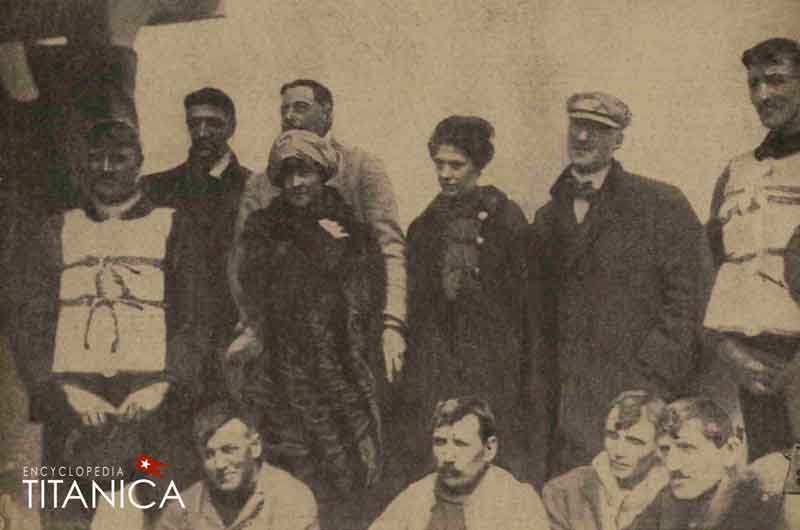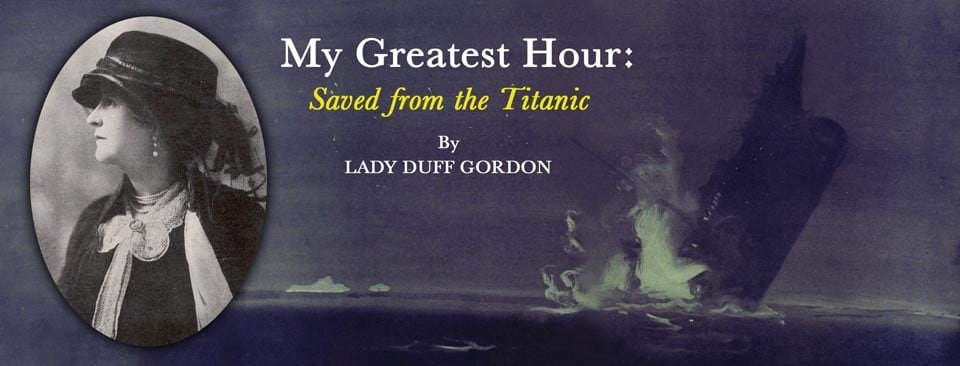In one of her last accounts of the Titanic disaster, over a year after the publication of her memoir, Lucy Duff Gordon tells in even more detail the most tragic experience of her life.
Introduction by Randy Bryan Bigham
As her biographer – my book, Lucile – Her Life by Design, was published in 2012 – I thought I’d read all of Lucy Duff Gordon’s most important personal accounts, including her memories of the sinking of Titanic. She almost never spoke of the ordeal. From the close of the British Inquiry, during which she testified and faced an onslaught of negative publicity, Lucy was content to leave the pain and aggravation behind as she resumed focus on her career as one of the Edwardian era’s most influential dress designers and colorful personalities. She didn’t talk publicly about Titanic in any detail again until she wrote her best-selling autobiography, Discretions and Indiscretions, released in March 1932. Twenty years had passed, and so had the acuity of some of her recollections, but the horror and shock she went through were still deeply felt.

Recently, I was surprised to come across the following article on Titanic that Lucy wrote for the once popular John Bull, published in the magazine’s Dec. 2, 1933 issue. It contains much of what Lucy had already written about the sinking and its aftermath, but she clarifies some of her memories and goes into a bit more detail at points. The immediacy of her emotion on the subject is still palpable to the reader. Appearing less than a year and a half before Lucy passed away at the age of 71 from breast cancer (complicated by pneumonia), it’s one of her final statements on the “most tragic chapter” of her life. As she died long before Titanic would once again enter popular culture, it’s unclear how she’d have dealt with it. This article is at least an indication that Lucy was beginning to come to terms with the agonizing story that she had previously pushed from her mind.
* * *
“Expecting Death, then – I saw Life again.” – Lady Duff Gordon
If you agree that, in normal circumstances, one’s most precious possession is life, then you will understand when I say that my greatest hour was that in which I passed from the Valley of the Shadow of Death, from disaster and agony, to emerge into a familiar world which I had never expected to see again.
It was a tragedy, swift and terrible, concentrated into one disastrous night – the night during which that great liner, the Titanic, struck an iceberg in the Atlantic and sank with hundreds of helpless victims, a tragedy all the greater because it occurred on the maiden voyage of a ship that was claimed to be unsinkable.
I shall never forget the happiness of that evening before the disaster nor the contrasting terror of the hours that followed. For truly happiness reigned on board that evening.
It was a perfect night for the Atlantic, calm and cold – and it was growing colder. That was significant, though perhaps none of us realized it at the time, for the growing coldness indicated the approach of icebergs.
But the gay crowds on board had no thoughts of icebergs and their attendant perils. They had no thought but to enjoy the idyllic evening. Nor had I.
With my husband, I had been enjoying all the pleasures of an Atlantic crossing; the idle, restful days after hard work, the varied and fascinating company of new friends and acquaintances, the leisurely dinners, the dancing, the soft, romantic music of the ship’s orchestra.1
* * *
All around were cheerful, laughing men and women and girls. Some were playing games, the more sedate were at the card tables, lovers and young people on honeymoon were secluding themselves in corners or wandering round the upper decks beneath the sky, dreaming perhaps of the future, but reckoning without the rapid approach of Death.
Yet to me, as the evening wore on, came an odd sense of foreboding. When one is very happy, one is often struck by a fear that such happiness cannot last. Certainly, I was conscious of this feeling on that awful night.
But I tried to put the fear from me. My husband went early to his cabin, and I sat for some time in the lounge talking to my secretary, before I, too, went to bed. And by the time I was dozing in the darkness, my fears had gone.2
Then suddenly, as from a great distance, came a low, rumbling sound. It might have been distant thunder or somebody rolling a bowl along the deck. With it came a slight tremor.
I heard people pattering along the deck outside, laughing and talking. “I expect we’ve hit an iceberg,” said one.
My fear returned. I went to my husband’s cabin and expressed my fear. He told me not to be absurd. I tried not to be absurd. I went back. I reassured myself. I took a last look around my cabin before putting out the light. And then a terrifying thing happened.
A vase of flowers on my table began to slide, gathered speed and crashed to the floor. A photograph of my daughter quickly followed. I knew then that my fear was justified: the ship was tilting – and on a calm sea.3
Then I missed the familiar throb of the engines, heard instead the hiss of escaping steam. Outside, a more excited trampling of feet, a steward entered, smiling, and asked me to put on my lifebelt as a little journey in a boat would be necessary. There was no longer any doubt.
How to describe the hour that followed? When I stood arm in arm with my husband on deck, watching the pandemonium, the lowering of boat after boat, the frantic plight for places in them, the confusion of voices, the crack of revolvers as the officers shot down Lascars who, mad with terror, were fighting like devils to get to the boats.4
How to describe the weeping, terrified women, the women calm and courageous, the husbands and brothers firm and reassuring? Familiar faces emerge from the jumble of stark impressions – Colonel John Jacob Astor, the Wideners, the Thayers, old Isidor Straus, all American millionaires…even today these memories are an agony.5
They tried to force me from my husband into a boat but I refused to leave him. And presently an officer came to us and said there was plenty of room in the captain’s emergency boat.6

Following their testimonies at the British Inquiry on May 20, 1912, the Duff Gordons with Miss Francatelli unsuccessfully tried to avoid photographers by exiting through a rear door at London’s Scottish Hall.
* * *
Then began the night of terror on the sea. As the sailors rowed frantically away from the great liner, I saw a row of lighted portholes sink beneath the dark waters, then another and another.
And presently there was a great explosion and the stern of the liner rose in the air and she plunged. She plunged, and the last porthole was extinguished, and a dreadful clamor of shrieks and cries filled the night and was extinguished suddenly, terrifyingly, like the porthole lights.
Then there was silence, except for the lap-lap of water against our frail boat. After that I was desperately ill for a long time. When I revived, the air was Arctic. Around us, in the dimness, I could see, not far away, vague, formless masses. They told me these were icebergs – one of them, perhaps, the same that had sent hundreds to their death.
I lay in the boat, sometimes conscious, sometimes happily in a state of oblivion. When I was fully conscious I was racked by terrible seasickness and tortured by memory. The sailors were rowing wearily – rowing heaven knew where, directionless, hopeless. Ice spray powdered us and they bailed water out of the boat.7
As the terrible night passed I began to wish for death to end the agony. I expected death, we all did. It seemed a forlorn hope, this anticipation of life. Every time a wave broke over us and the frail craft was thrown about like a feather, we thought that our last moment had come.8
Yet somehow we survived and after an eternity, we saw the first gleam of dawn across the sea. Hope always returns with the dawn, and with that first frostiness of light on the horizon, our expectation of survival was renewed. While all eyes in the boat were riveted on the eastern sky, I had an impulse to turn and look toward the still dark west. And I cried out, for I thought that far away I saw a light.
At first, the others would not believe me, but a few minutes later the light appeared again. It grew stronger and suddenly the wearied sailors at the oars were galvanized into life. They turned the boat and with renewed strength began to row toward that faint glow of hope.

Standing from left to right are an unidentified crewmember (possibly James Taylor) an unidentified man, Cosmo Duff Gordon, Lucy Duff Gordon, Mabel Francatelli, Abraham Salomon and Charles Hendrickson. Seated from left, George Symons, Albert Horswill, Sam Collins and an unidentified crewmember. Another member of the crew is missing from this image as well as passenger Henry Stengel. The photo, taken by Carpathia passenger Dr. Frank Blackmarr, appeared in the Daily Sketch (London), May 21, 1912.
* * *
We who had expected death now had hope of life, exhausted bodies lying in the bottom of the boat. It seemed that even the sea grew calmer in sympathy.9
But it was many hours before that light, fading with the dawn, gave place to the form of a ship. It was the Carpathia, racing across the Atlantic to the scene of the disaster.10
After the exhilaration of new hope, reaction set in. I was again oblivious and when my eyes opened to the daylight, I saw only half a mile away the great bulk of the Carpathia. I saw Life again.
It was an hour before we reached her, before I was pulled half-dead up the rope ladder they let down the side of the ship, before two pairs of muscular arms reached out and lifted me onto the deck and a stewardess wrapped blankets round me. I was carried away and given brandy that felt like liquid fire before I sank again into oblivion, this time in a warm and sheltered cabin, my greatest hour.

Notes
- Lucy, Lady Duff Gordon’s husband (her second) was Sottish landowner and sportsman Sir Cosmo Edmund Duff Gordon. Lucy, a leading fashion designer (known as Lucile) had recently presented her spring 1912 collection at the Paris and London branches of her couture house, Lucile Ltd. She was en route to New York to sign the lease on a new, larger facility for her branch there and to supervise interior decorating and other preparations for the opening of the new house. Sir Cosmo, who normally did not accompany his wife on business, volunteered to go with her to New York because she expressed anxiety about being on a ship’s maiden voyage. Among friends aboard, she recalled John B. Thayer and his wife Marian. Lucy was also professionally associated with Broadway producer Henry B. Harris whose current production of The Quaker Girl she had costumed. She hadn’t previously met his wife, Renée, until Titanic’s voyage. There was no dancing observed in first-class aboard the ship.
- The Duff Gordons were traveling with Lucy’s business secretary, Mabel Francatelli, who occupied an E Deck stateroom while Cosmo and Lucy were berthed in individual cabins located across a short passage from each other on A Deck.
- Although this description may be an exaggeration of the list, there’s some indication that others noticed the deck was already slightly inclined toward the bow as well as to starboard during the first few minutes following the collision.
- Lucy’s description here is melodramatic; there was no panic aboard at this stage of the emergency; her own feelings of unease and concern may have colored her memories. There was, however, some confusion noted by others on the portside of the boat deck early on when lifeboat no. 4 was lowered to A Deck for loading passengers who couldn’t enter until the promenade windows were opened, activity that was delayed for more than an hour. As the Duff Gordons were known to have been on the port boat deck briefly before crossing to starboard, the anxiety of witnessing this disorder may be what Lucy was recalling. The known incidents of gunfire on Titanic occurred after Lucy had departed the ship in a lifeboat, although it’s possible she heard the shots from her boat. Lascars referred to Indian or Southeast Asian sailors which is probably an inaccurate assessment of these men’s nationality.
- In her memoir, Lucy recalled seeing the Astors, Strauses, Thayers and Wideners earlier in the voyage (some of them on the evening of April 14 at dinner), but she probably didn’t encounter any of these people between the time of the collision and when she left the ship.
- Crewmembers attempted to place Lucy and her secretary in lifeboat no. 3. In her memoir and in her British Inquiry testimony, she said First Officer William Murdoch, in charge of launching lifeboats on the starboard side, was approached by her husband about entering lifeboat no. 1 and that the couple and Mabel Francatelli received his permission to do so; Murdoch did not approach them.
- Water wasn’t reported by others as having collected in the bottom of lifeboat no.1.
- The sea was calm until just before dawn.
- It appears that Lucy misremembered that the ocean was calm until they were rowing toward the Carpathia near dawn. Any waves that she witnessed would have happened at that point only.
- It appears Lucy’s conception of time was affected by her emotions; it wasn’t “hours” between the sighting of Carpathia and its picking up the occupants of lifeboat no.1. Boat 1 was the second lifeboat rescued by the ship at about 4:45 a.m. April 15.
Acknowledgements
Thank you to Bruno Piola and Gregg Jasper.


Comment and discuss